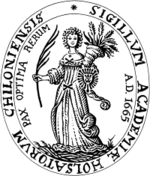Christian-Albrechts University
| Christian-Albrechts-Universität zu Kiel | |

Seal of the University of Kiel
|
|
|
Latin: Academia Holsatorum Chiloniensis sive Christiana Albertina |
|
| Motto | Pax optima rerum |
|---|---|
|
Motto in English
|
Peace is the greatest good |
| Type | Public |
| Established | 1665 |
| President | Lutz Kipp[] |
|
Administrative staff
|
2,175 |
| Students | 26,000 |
| Location | Kiel, Germany |
| Campus | Urban |
| Colors | Purple and white |
| Website | www |
The University of Kiel (German: Christian-Albrechts-Universität zu Kiel, CAU) is a university in the city of Kiel, Germany. It was founded in 1665 as the Academia Holsatorum Chiloniensis by Christian Albert, Duke of Holstein-Gottorp and has approximately 26,000 students today. The University of Kiel is the largest, oldest, and most prestigious in the state of Schleswig-Holstein. Until 1864/66 it was not only the northernmost university in Germany but at the same time the 2nd largest university of Denmark. Faculty, alumni, and researchers of the University of Kiel have won 12 Nobel Prizes. The University of Kiel is a member of the German Universities Excellence Initiative since 2006. The Cluster of Excellence The Future Ocean, which was established in cooperation with the GEOMAR Helmholtz Centre for Ocean Research Kiel in 2006, is internationally recognized. The second Cluster of Excellence "Inflammation at Interfaces" deals with chronic inflammatory diseases. The world-renowned Kiel Institute for the World Economy is also affiliated with the University of Kiel.
The University of Kiel was founded under the name Christiana Albertina on 5 October 1665 by Christian Albert, Duke of Holstein-Gottorp. The citizens of the city of Kiel were initially quite sceptical about the upcoming influx of students, thinking that these could be "quite a pest with their gluttony, heavy drinking and their questionable character" (German: mit Fressen, Sauffen und allerley leichtfertigem Wesen sehr ärgerlich seyn). But those in the city who envisioned economic advantages of a university in the city won, and Kiel thus became the northernmost university in the German Holy Roman Empire.
...
Wikipedia
